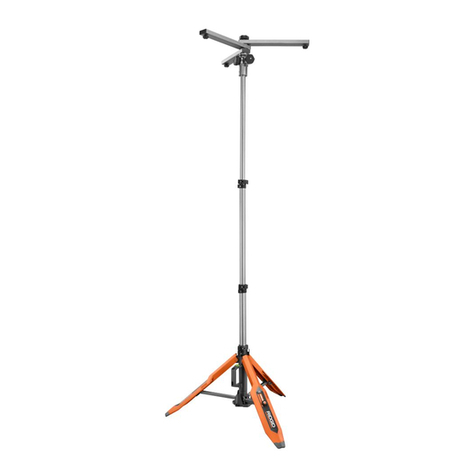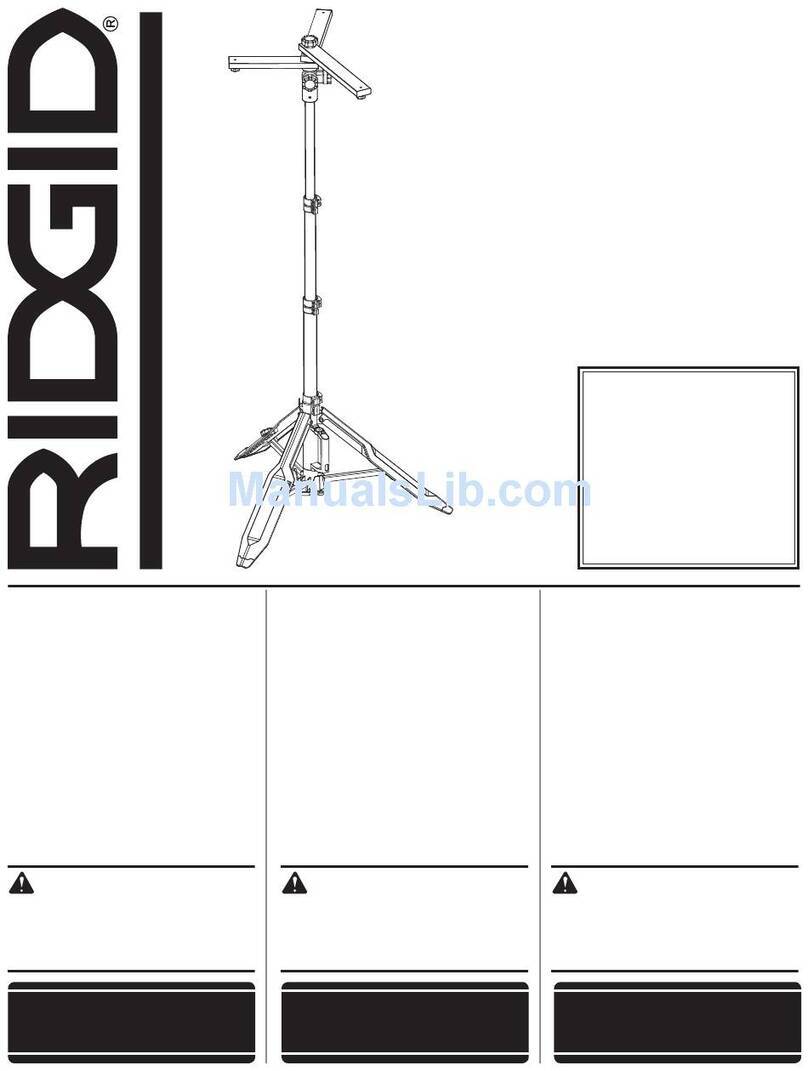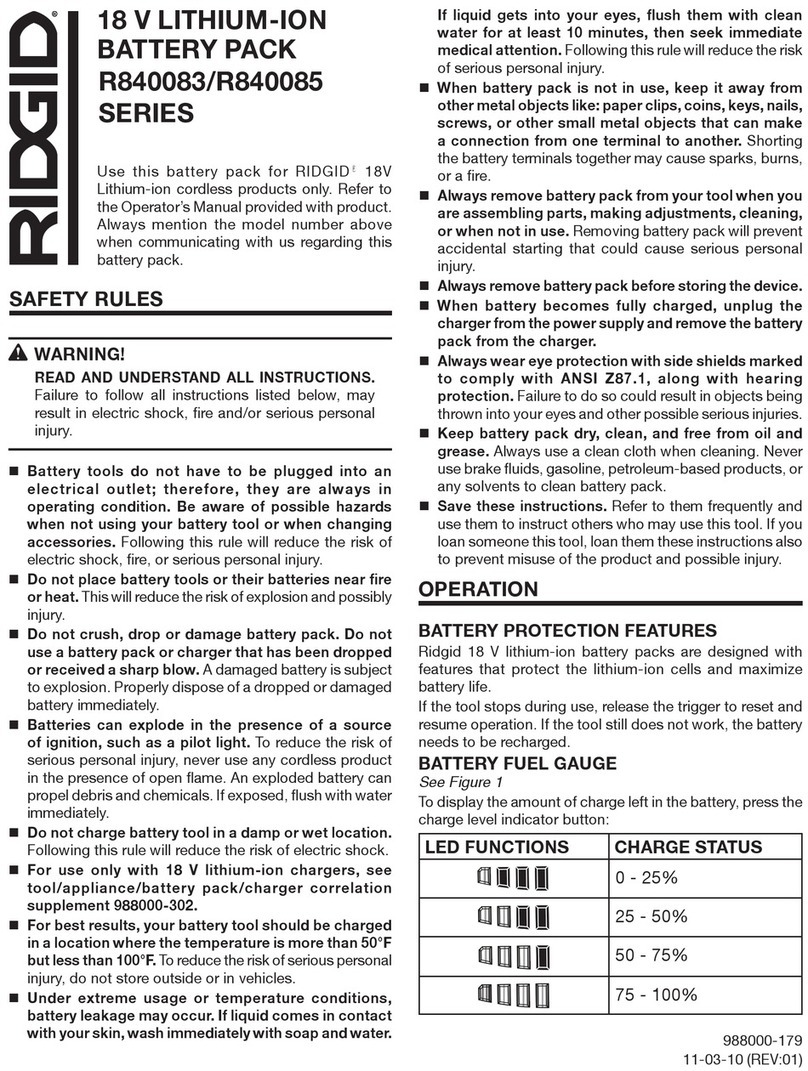RIDGID SeekTech SR-20 User manual

RIDGE TOOL COMPANY
Tools For The ProfessionalTM
SeekTech
SR-20

Ridge Tool Company 1
Tools For The ProfessionalTM
seekTech sR-20
General Safety Information
WARNING! Read these instructions
and the accompanying safety
booklet carefully before using
this equipment. If you are
uncertain about any aspect of using this tool,
contact your RIDGID distributor for more
information.
Failure to understand and follow all
instructions may result in electric shock,
re, and/or serious personal injury.
SAVE THESE INSTRUCTIONS!
CAUTION: Remove batteries entirely before shipping.
If you have any questions regarding the service or repair
of this machine, contact your Ridgid distributor, your local
Ridgid oce or Ridge Tool Europe at info.europe@ridgid.
com
DANGER
•The SR-20 is a diagnostic tool that senses electromagnetic
elds emitted by objects underground. It is meant to
aide the user in locating these objects by recognizing
characteristics of the eld lines and displaying them on
the screen. As electromagnetic eld lines can be distorted
and interfered with, it is important to verify the location
of underground objects before digging.
•Several utilities may be underground in the same
area. Be sure to follow local guidelines and one-call
service procedures.
•Exposing the utility is the only way to verify its
existence, location, and depth.
•Ridge Tool Co., its aliates and suppliers, will not be
liable for any injury or any direct, indirect, incidental
or consequential damages sustained or incurred by
reason of the use of the SR-20.
In any correspondence, please give all the information shown
on the nameplate of your tool including model number and
serial number.
GB
SeekTech SR-20
Operating Instructions

Ridge Tool Company
2
Tools For The ProfessionalTM
seekTech sR-20
SR-20 Components
Figure 1: SR-20 Components
Battery Compartment
Serial Port Connector
USB Connector
Icon Reference
Note: USB/ Serial Ports are
for loading new software
Serial Number Label
Antenna Mast
Upper Antenna
Node
Folding Joint
Lower Antenna
Node
Guidance
Antennas
Display Screen
Keypad
Handle
Speaker
Folding Mast Snap

Ridge Tool Company 3
Tools For The ProfessionalTM
seekTech sR-20
Introduction to the SR-20
Getting Started
Installing/Changing Batteries
Figure 2: Battery Case
CAUTION: Do not allow debris or moisture into battery
compartment. Debris or moisture may short the battery
contacts, leading to rapid discharge of the batteries, which
could result in electrolyte leakage or risk of re.
Folding Mast
IMPORTANT! Do not snap or whip the SR-20 mast to open or
close it. Open it and close it by hand only.
NOTE: Avoid dragging the lower antenna node on the
ground while locating with the SR-20. It may cause signal
noise which will interfere with results, and may eventually
damage the antenna.
Figure 3: Folding Antenna Mast and Release Button
SR-20 Modes
The SR-20 operates in three distinct modes. They are:
1. Active Line Trace Mode, used when a chosen
frequency can be put onto a long conductor using a
Line Transmitter, for locating conductive pipes, lines,
or cables.
2. Passive Trace Mode, used for tracing electrical lines
that are already carrying 60 Hz current (U.S.), 50 Hz
current (Europe), or radio frequencies.
3. Sonde Mode, used for locating Sondes in pipes,
conduits, or tunnels that are non-conductive or
cannot otherwise be traced.
Release Button

Ridge Tool Company
4
Tools For The ProfessionalTM
seekTech sR-20
Display Elements
The “basic features” of the SR-20 are on by default. Features
can be turned o or hidden to make the display clearer when
doing basic locating in uncomplicated situations.
Common Display Elements
Current Strength/
Signal Angle
Battery Level
Crosshairs
(Map Center)
Active View Area
Frequency
Mode
Depth/
Distance
Figure 4: Common Display Elements
The display screen in Active Line Trace, Passive Line Trace or
Sonde mode will show the following features:
• Active View Area – The area inside the circle on the
SR-20 display where the Tracing Line, Guidance Arrows,
and crosshairs are displayed.
• mA Current Strength – Proportional to current on
the line. Switches to Signal Angle when Signal Angle is
greater than 35°.
• Signal Angle – Field tilt from the horizontal; angle
toward the eld’s center; numeric value displayed in
degrees.
• Battery Level – Indicates level of remaining
battery capacity.
• Measured Depth/Distance – Displays the measured
depth when receiver is touching the ground directly over
signal source. Displays computed distance when the
antenna mast is pointed at a signal source in some other
manner. Displays feet/inches (U.S.A. default) or meters
(European default).
• Mode – Icon for Sonde , Line Trace , Power (Passive
Line Trace) , or Radio Frequency mode.
• Frequency – Shows current frequency setting in hertz or
kilohertz.
• + Crosshairs (Map Center) – shows operator’s position
relative to the target center.
Display Elements: Active Line Trace Mode
Proximity
Signal
Guidance Arrows
Tracing Line
Signal Strength
Figure 5: Display Elements (Line Trace Mode)
In Active Line Trace Mode, the following features will also be
displayed:
• Proximity Signal – Numerical indication showing how
close the signal source is to the locator. Displays from 1 to
999. (Line Trace modes only)
• Signal Strength – Strength of signal as sensed by the
lower Omnidirectional antenna.
• Tracing Line – The Tracing Line represents the
approximate axis of the detected eld. It represents detected
distortion in the eld by appearing less focused. (See page 22
for information on setting the sensitivity and how to enable
or disable the distortion response in the Tracing Line.)
• Distortion Line – If the normal distortion
response of the Tracing Line is disabled, a second line is
shown, which represents the signal from the upper antenna
node. By comparing the two lines, the user can estimate the
degree of distortion present in a signal.
• Guidance Arrows – The Guidance Arrows serve to
steer the operator toward the center of the detected eld, by
showing when the signals reaching the left and right.
Proximity
Signal Tracing Line
Guidance Arrows
Signal Strength
Frequency
Depth/
Distance
Mode
Current Strength/
Signal Angle
Battery Level
Active View Area
Crosshairs
(Map Center)
Other manuals for SeekTech SR-20
2
Table of contents
Other RIDGID Camera Accessories manuals
Popular Camera Accessories manuals by other brands

Trojan
Trojan GC2 48V quick start guide

Calumet
Calumet 7100 Series CK7114 operating instructions

Ropox
Ropox 4Single Series User manual and installation instructions

Cambo
Cambo Wide DS Digital Series Main operating instructions

Samsung
Samsung SHG-120 Specification sheet

Ryobi
Ryobi BPL-1820 Owner's operating manual














